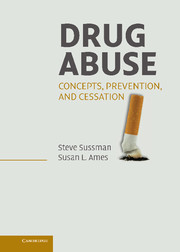Book contents
- Frontmatter
- Contents
- Preface
- Acknowledgments
- SECTION ONE CONCEPTS AND CLASSES OF DRUGS
- SECTION TWO ETIOLOGY
- 4 Current Multivariable Models
- 5 Neurobiologically Relevant
- 6 Cognitive Processes
- 7 Social Interaction and Social Groups
- 8 The Large Social and Physical Environment
- 9 Assessment
- SECTION THREE PREVENTION
- SECTION FOUR CESSATION
- SECTION FIVE CONCLUSIONS AND THE FUTURE
- References
- Author Index
- Subject Index
8 - The Large Social and Physical Environment
Published online by Cambridge University Press: 18 December 2009
- Frontmatter
- Contents
- Preface
- Acknowledgments
- SECTION ONE CONCEPTS AND CLASSES OF DRUGS
- SECTION TWO ETIOLOGY
- 4 Current Multivariable Models
- 5 Neurobiologically Relevant
- 6 Cognitive Processes
- 7 Social Interaction and Social Groups
- 8 The Large Social and Physical Environment
- 9 Assessment
- SECTION THREE PREVENTION
- SECTION FOUR CESSATION
- SECTION FIVE CONCLUSIONS AND THE FUTURE
- References
- Author Index
- Subject Index
Summary
This chapter addresses the larger physical and social environmental influences on drug misuse development (e.g., drug availability and neighborhood organization), including geographic and cultural information that characterizes one's environment. Several theoretical models have been used to examine this etiologic arena. For example, Szapocznik and Coatsworth's (1999) Ecodevelopmental Model – based in part on Bronfenbrenner's (1979) Ecological Systems Theory – examines the child within and across ecological systems that may be involved in risk and protective processes that influence drug use. These processes represent interactions of youths with their families, community units, and larger scale physical and cultural influences. The present chapter focuses on molar levels of analysis or influences of these larger scale complex systems.
Physical environmental influences on drug misuse vulnerability can be categorized as the size, density, and configuration of geographical areas that could either constrain or facilitate drug misuse. Such influences include large-scale constraints, such as the presence of prosocial physical environmental resources like museums and fitness clubs or views of nature that have calming effects. Aspects of an environment reflective of community disorganization that could lead to psychological stress and maladaptive coping include exposures to dilapidated or unprotected structures that provide places for drug distribution, high alcohol outlet density, or crowding, crime presence, and noise. We place community disorganization as a “physical” environmental influence though it could also be conceptualized as a large social environmental influence.
- Type
- Chapter
- Information
- Drug AbuseConcepts, Prevention, and Cessation, pp. 109 - 122Publisher: Cambridge University PressPrint publication year: 2008



